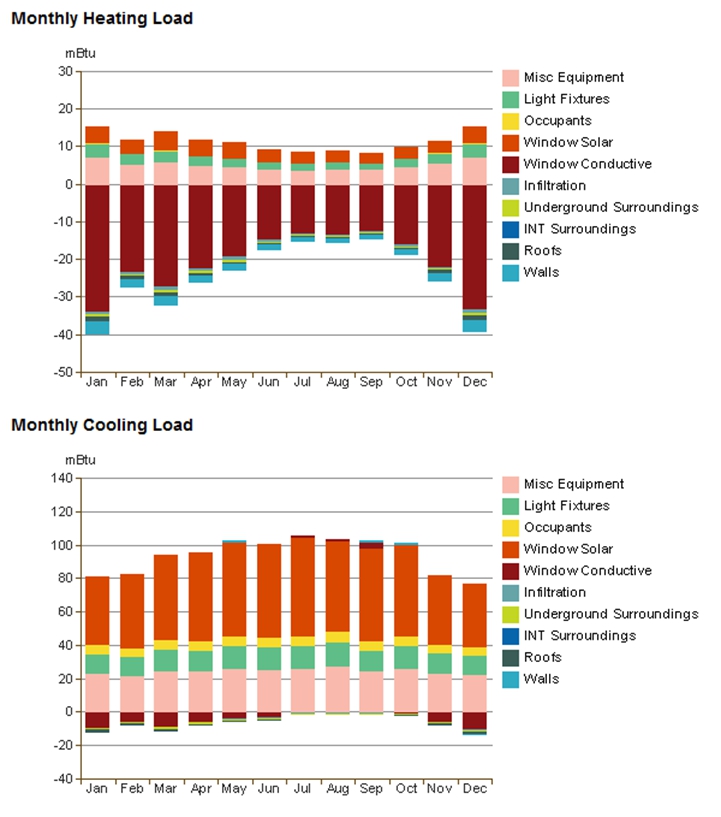You are here
Thermal loads are the amount of energy needed to be added or removed from a space by the HVAC system to keep occupants comfortable. Right-sizing the HVAC system requires understanding the heating and cooling loads within the space.
High performance buildings seek to reduce these loads as much as possible, and meet these loads as efficiently as possible.
 |
|
The building program determines whether internal or external loads dominate. |
By understanding the building’s thermal loads and its intended use, you can more effectively use energy from the sun and the wind to passively heat, cool and ventilate your building, light your building, and design efficient HVAC systems. You can even generate energy on-site using resources that would otherwise be thermal loads that would demand energy.
External thermal loads
External thermal loads come from heat transfer through the building envelope from the sun, the earth, and the outside environment (and weather). The building envelope includes walls, roofs, floors, windows, and any other surfaces that separate inside and outside. They are sometimes also called envelope loads, fabric loads, skin loads, or external gains/losses.
These loads include the energy embedded in the moisture of the air (see sensible vs. latent heat).
Some common ways that heat flows into or out of a building are:
- Heat conduction entering or leaving the building envelope to outside air or ground
- Sunlight (radiant energy) entering through windows to heat interiors or store energy in thermal mass (direct solar gains)
- Sunlight warming up exterior building surfaces ("indirect solar gains")
- Losing inside air to the outside, or vice-versa, through leaks and infiltration
- Air being intentionally introduced to the building to provide fresh air/ventilation or being exhausted from point sources.
Material choices, envelope design, and envelope sealing dramatically affect the amount of solar conducted and convected energy that enters and leaves the building envelope. The degree to which each of these impact the building’s loads and the occupant’s comfort also depend on the temperature and humidity differences between indoors and outdoors, which are all constantly changing by season and time of day.
Understanding where heat energy is gained and lost in your design is an important first step towards successful passive design strategies. When it’s hot and sunny, it can be very important to reduce loads from solar radiation by using properly designed shades and windows with low solar heat gain. On the other hand, in a cold climate or in the winter, it’s often desirable to capture this free solar energy in some way.
See more on climate considerations
See more on heat transfer and thermal properties
See more on infiltration and latent heat
See more on shading design
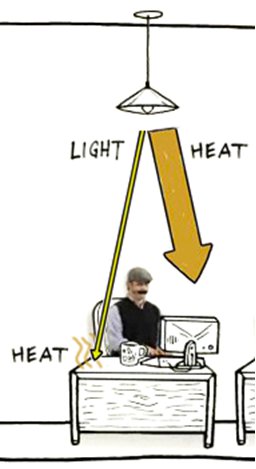 |
|
All lighting energy becomes heat eventually |
Internal Thermal Loads
Internal thermal loads come from heat generated by people, lighting, and equipment. These are also sometimes called core loads or internal gains. Lighting and most equipment loads are sensible heat, while the metabolic heat generated by people bodies are a combination of sensible and latent loads. Some buildings or spaces are dominated by less common internal sources of sensible and latent internal loads such as large kitchens, swimming pools and locker rooms and health clubs or industrial processes.
The internal gains from lighting and equipment are generally equal to their energy use: when a light fixture converts a watt-hour of electricity into photons, those photons bounce around the room until they get absorbed, turning their light energy into heat energy.
Likewise, all the electrical energy that the lighting fixture did not turn into photons turns directly into heat energy, due to inefficiency.
The same is true of equipment: electrical energy used to move mechanical parts is transformed into heat via friction, energy used to power electronics turns into heat via electrical resistance, etc.
The thermal load of people depends on the number of people and their activity level. It can be as little as 70-80 watts for an adult sleeping to over 1,000 watts for an athlete engaging in intense exercise.
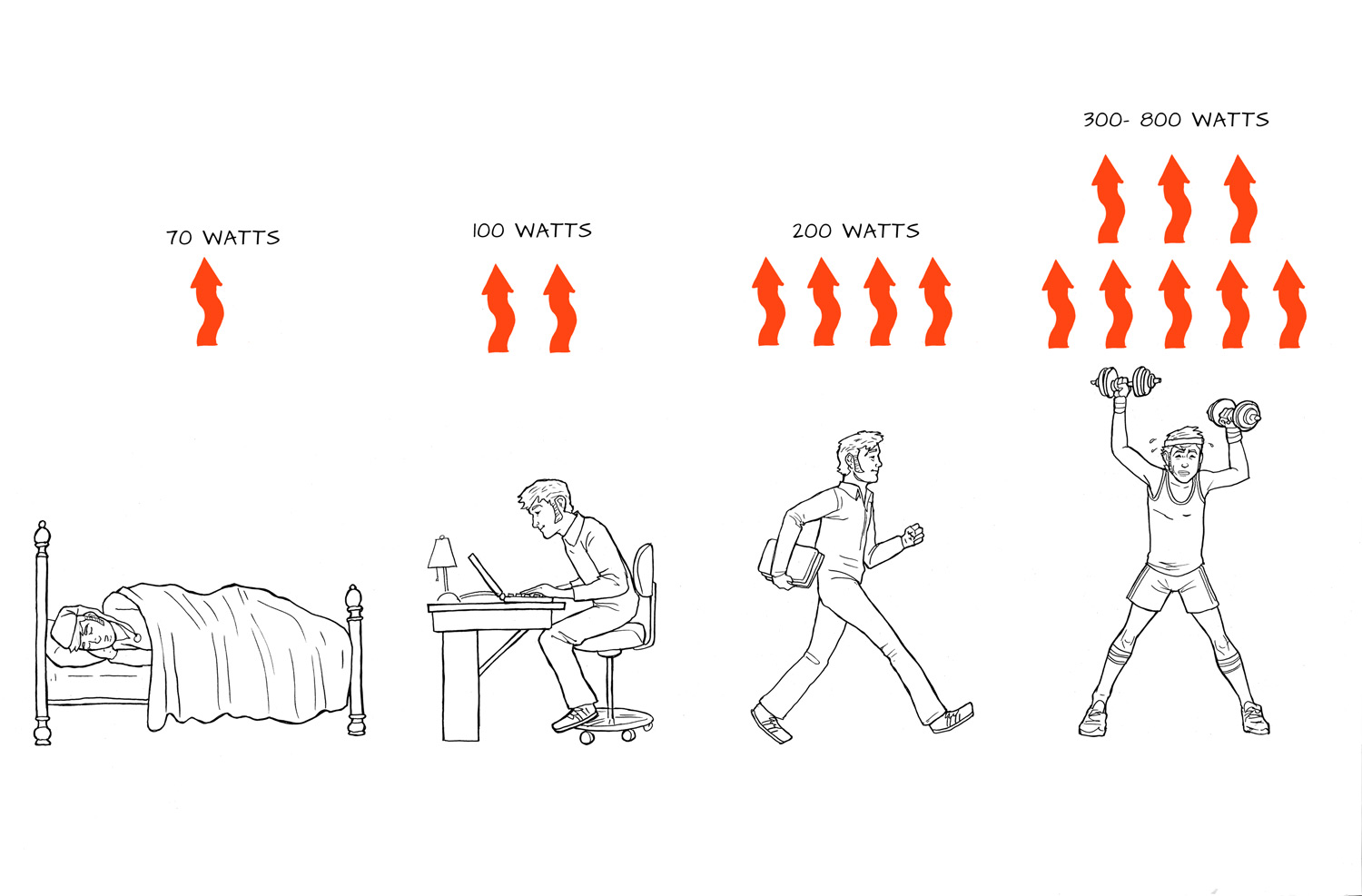 |
|
Thermal loads from people doing different activities |
| Activity | Watts |
| Sitting | 100 |
| Standing at ease / Conversation | 130 |
| Eating meal | 130 |
| Strolling | 160 |
| Housekeeping | 175 |
| Heavy work (e.g. carpentry) | 270 |
| Fast walking / Hiking | 400 |
| Long distance running | 1,000 |
| Sprinting | 1,600 |
| Table values from Starner, T. and Paradiso, J.A., "Human Generated Power for Mobile Electronics," in Piguet, C. (ed), Low-Power Electronics, CRC Press, Chapter 45, 2004. | |
Internal vs. External Loads
Densely populated buildings with high activity and/or energy-intensive equipment (e.g. office buildings, movie theaters) are generally dominated by internal loads, while sparsely populated buildings with little activity or equipment (e.g. single family residences, warehouses) are generally dominated by external loads.
The building program and massing also help determine how important internal heat loads are compared to external loads from sun, wind, and ambient temperatures.
Heating and Cooling Loads
Internal and external thermal loads translate to heating and cooling loads. This is how much heat energy you need to heat and cool the building, and control moisture within the building.
Loads are usually calculated as the amount of energy that needs to be moved into or out of the building to keep the temperature at a specified point (setpoint).
- If heat gains are greater than envelope and ventilation losses, the building or space has a net cooling load (the building is too hot).
- If heat losses are greater than the internal gains, the building or space has a net heating load (the building is too cold).
- The heating thermostat setpoint is often different than the cooling thermostat setpoint both to save energy and because of human preference. The distribution of heating and cooling loads is climate dependent.
The heating and cooling loads below provide a break-down for what drives the heating and cooling energy demand.
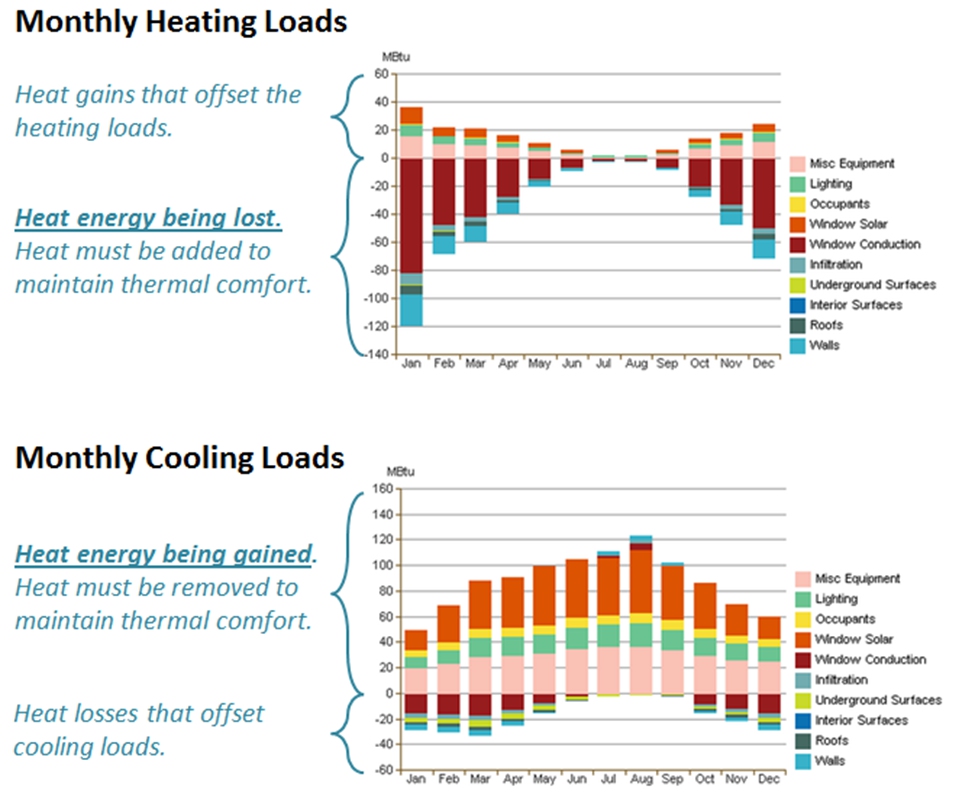 |
|
An explanation for how to interpret heating and cooling load charts. |
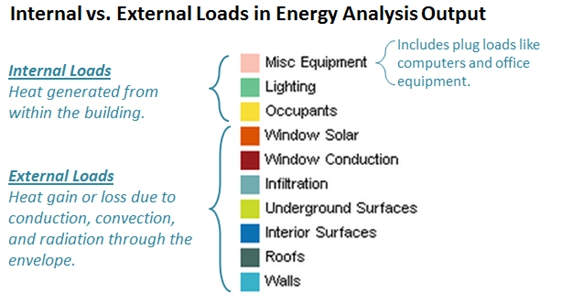 |
When interpreting energy load charts, pay attention to whether the biggest heat losses and gains come from internal or external loads. |
Also note that it is the PEAK heating and cooling loads that are used by engineers to size HVAC equipment. These energy analysis graphs are meant to help understand energy flows, not size equipment. However, using energy analysis tools can allow you to better understand and calculate energy use so that you can avoid oversizing equipment and look past the typical “rules of thumb.”
For guidance on how to make these calculations, look at the links provided below and reference texts like Mechanical and Electrical Equipment for Buildings By Walter T. Grondzik, Alison G. Kwok, Benjamin Stein, John S. Reynolds.
Using Energy to Meet Heating and Cooling Loads
The values in the heating and cooling load charts above represent the amount of heating or cooling required, not the amount of energy a HVAC system would actually consume to generate the required load.
Passive systems reduce the energy demand or meet it naturally. Active systems move heat and moisture using gas or electricity. How much and what type of fuel the HVAC system will consume depends on the system type and efficiency.
When using active systems, it usually takes more energy to meet heating loads than it does to meet cooling loads. Heating systems based on combustion of a fuel are approximately 75%-95% efficient at converting the chemical energy in the fuel to heat delivered to the building. The efficiency of cooling systems (and heat pumps in heating mode) is not measured in percent efficiency because they do not convert potential energy to delivered heat, rather they use energy, most commonly electricity, to move heat either into or out of a building. The Whole Building Design Guide provides ranges of efficiency values and sizes that are typical for various types of cooling systems – see WBDG. Heat pumps and air conditioners use energy to move heat, they do not generate coolth – see Heat Pumps). The cooling effect that we feel is the removal of heat rather than the addition of coolth.
Also, when you put cost into the equation it brings another level of complexity because heating fuel is much cheaper per unit of energy than electricity. Building owners often spend more on energy to cool their building than to heat their building. There are many reasons for this, but the easiest to understand is that electricity typically costs three to five times more than heating fuel per unit of energy.
Balance Points
The concept of a building’s balance point can help designers determine when heating or cooling is required in the building. The balance point is the outdoor temperature at which the building makes a transition from a heating need to a cooling need. It is calculated by comparing internal heat gains (from people, equipment, etc) with external heat losses (from building infiltration, etc). It is not the ideal comfort temperature inside the building. It is the temperature at which the building's heat gains equal its losses.
- If the temperature is BELOW the balance point, heating is required.
- If the temperature is ABOVE the balance point, cooling is required.
- If the temperature is AT the balance point, no heating or cooling is required, because the building is gaining as much heat as it is losing.
For example, if the balance point of a building is 65 degrees Fahrenheit and the outdoor temperature is 75 degrees Fahrenheit, a passive cooling strategy like shading would be helpful at that time.
Buildings that have high internal heat gains (like offices), and low rates of heat loss (well-sealed and well-insulated), will have a lower balance point.
Links and References
- A document from the USDOE that explains the fundamentals of heating and cooling load calculations
- An explanation of sensible and latent heat cooling load calculations

